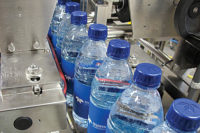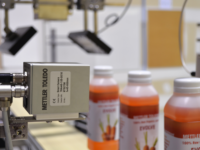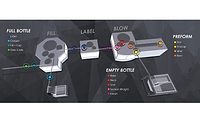
Packaging Inspection Equipment
By JOANNA COSGROVE
The right equipment not only preserves beverage
purity but also can improve production line efficiencies
For as long as there have
been commercially produced beverages, there
have been half-baked urban legends about sinister items like syringes and
other unsavory things supposedly lurking inside beverage containers. Given
the level of sophistication delivered by modern beverage inspection
equipment, the odds of a mass produced beverage containing foreign matter
is highly unlikely. But that’s not to say the equipment doesn’t
have its work cut out for it.
Even transparent plastic packaging poses unique
challenges in terms of inspection quality control, says Rick Reardon,
product line manager, Teledyne TapTone, North Falmouth, Mass.
“Packagers are faced with new and sometimes challenging applications
such as liquid nitrogen (LN2) dosing containers at high production speeds. Hot filling
plastic beverage containers or introducing a new cap or closure can also
create special challenges for beverage manufacturers who traditionally
packaged in glass,” he says. “Quality control has become an
issue we find many packagers are grappling with and leak detection in
plastic containers has become a priority.”
Teledyne TapTone’s series of inspection systems
are designed specifically to address the issue of leak detection in
pressurized and non-pressurized plastic containers at full production
speeds.
Designed with dual parallel chains suspended over an
existing conveying system, the T1000 Dual Sensor Compression system detects
micro leaks in non-pressurized plastic containers. As the container passes
through the system, the dual parallel belts apply force to the sidewall of
the container. This action compresses the headspace of the container, which
allows a comparative measurement to be taken at both the infeed and the
discharge of the system. Comparing the container to its reading at the
infeed and discharge eliminates variations that can occur in the production
environment.
The TapTone T1000 Force system detects leaks and low
LN2 in
flexible plastic bottles as well as low pressure in plastic carbonated
beverage bottles and aluminum cans. Parallel belts transport the container
past a load cell that measures the tension on the sidewall of the
container. This action allows the system to measure the pressure inside the
container and automatically reject all bottles that fall below or above the
acceptable pressure range.
When “gremlins” plague a packaging line
and threaten to compromise efficiencies, manufacturers can also turn to a
video recording of the production line to determine the root cause of
quality and production issues, says Jim Dechman, president and chief
executive officer, Monitoring Technology Corp. (MTC), Fairfax, Va. “It’s
good to catch an issue before it ships to the consumer, but it is better to
fix the problem permanently so it doesn’t happen again,” he
says.
MTC’s 20/20 Hindsight(gigE) transforms the
notion of high-speed video into plug-and-play industrial device. Its
gigabyte Ethernet (gigE) technology supports recording speeds in excess of
2,000-3,000 frames per second. The unit keeps hours of video in memory,
allowing a bottler to point a camera at a suspected problem area and easily
replay video after the next issue occurs.
Countering label mishaps
Rogue cans — or mixed labels that could, for
example, result in a sugared drink in a diet
drink can or an alcohol drink in a soft drink can — have been a
problem for years. However, recent changes in the neck diameter in the
beverage can industry have led to a sharp increase in mixed label
occurrences, says Bud Patel, vice president of business development at
Applied Vision, Akron, Ohio. “With the need to shave cost from the
cans, manufacturers are driving to standardize the 202 neck size,” he
says. “This increases the probability for mixed labels, since now all
beer and beverage cans will be manufactured and filled with the same
equipment.”
There are currently a number of solutions in the
marketplace to perform rogue can detection. These solutions work well when
there is a clear distinction between two different cans but leave a lot to
be desired when it comes to differentiating between similar labels or when
decoration processes drift slightly in color.
In response to industry demand for a reliable mixed
label inspection solution, Applied Vision developed a Mixed Label Inspection (MLI) system. During a two-month evaluation period
conducted by two major can manufacturers, the system inspected about two
million cans per day and detected all deliberately mixed label
introductions with a negligible false reject rate.
Termed a self-learning system, MLI first learns the
normal color and/or brightness variations of the production run, which
builds a resistance to false rejects. Secondly, it self-learns during label
changes. “When a new set of labels begins to pass by the Applied
Vision system, it automatically learns what they look like and continues
its mixed label detection on the new label,” Patel says. This allows
the system to run reliably without any operator intervention.”
Quality, as it relates to container integrity as well
as product quality, is paramount, comments Rick Cash, marketing technology
manager at Thermo Electron Corp’s Process Instruments division, a
Minneapolis-based manufacturer of inspection solutions for both raw
materials and finished products. “The beverage product has to be high
quality and the container has to ensure the beverage retains the initial
quality all the way to the consumer.”
Looking forward, Cash sees the influence of new
technology enabling beverage producers to maintain or improve quality with
greater cost efficiency. “Our strategy is to transfer our
considerable laboratory knowledge and technology to the production line,
which will enable beverage producers to improve their process through
direct quality measurements,” he says. “In-line measurement
also helps beverage manufacturers increase the productivity of their lab
personnel by eliminating the need to do repetitive off-line tests.”
Thermo Electron soon will release its new CrystalVision sensor for dissolved carbon dioxide, which uses
mid-infrared light to measure carbonation within the beverage process
stream. With no moving parts or consumables, the sensor continuously
processes data and has the ability to measure true carbon dioxide.
“Current methods of measurement are either manual sampling,
systems that are affected by influences such as dissolved oxygen, or
alcohol, brix and specific gravity, which must be factored out of the data
analysis,” Cash notes. “Carbonated beverage producers have told
us the importance of accurate CO2 control, as it influences taste, drinkability, product
waste and package storage. All of these metrics directly lead to the bottom line.” BI


